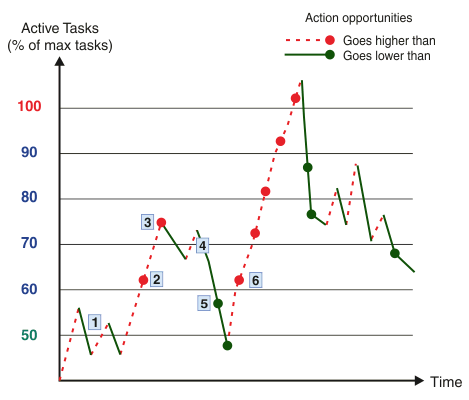User tasks and transaction class tasks system rules
- 60%, 70%, 80%, 90%, and 100% when the
Goes Higher Than
operator is used. - 50%, 60%, 70%, 80%, and 90% when the
Goes Lower Than
operator is used.
You can filter on a threshold to indicate how close the system is to the MXT value. You can define more than one system rule to indicate various degrees of health as the threshold gets closer to the limit that you set for the MXT system initialization parameter.
You can filter on the TRANCLASS and a threshold to indicate how close the TRANCLASS is to its MAXACTIVE value. You can define more than one system rule to indicate various degrees of health as the number of attached tasks gets closer to the MAXACTIVE limit that you set for the TRANCLASS resource.
To avoid large numbers of messages or events being emitted, user tasks and transaction class tasks system rules are evaluated only when the number of active tasks crosses a threshold value and has been either above the next higher threshold or below the next lower threshold since last time when rules for that threshold value were evaluated.
For example, any goes above 60% of MXT
rule is evaluated during transaction attach only when the number of active tasks exceeds 60% of the MXT value and the number of active tasks was above 70% of MXT, or below the 50% of MXT, since the goes above 60% of MXT
rule was last evaluated. Figure 1 shows examples to help you understand this algorithm.

Rules are evaluated as follows:
1 No user tasks or transaction class tasks rules are evaluated when the number of active tasks exceeds the 50% threshold. Rules are evaluated during transaction attach only when the number of active tasks goes above the 60%, 70%, 80%, 90%, or 100% thresholds, and during transaction detach when the number of active tasks goes below the 50%, 60%, 70%, 80%, or 90% thresholds. No rules are evaluated when the number of active tasks fluctuates around the 50% threshold, because the number of active tasks was not above the 60% threshold since any goes below 50%
rules were last evaluated.
2 Rules are evaluated because the number of active tasks crosses the 60% threshold for the first time since it last crossed the 50% threshold.
3 Rules are evaluated because the number of active tasks crosses the 70% threshold for the first time since it last crossed the 60% threshold.
4 No rules are evaluated when the number of active tasks oscillates around the 70% threshold because the number of active tasks does not go above 80%, or below 60%, in the intervening period of time.
5 Rules are evaluated because the number of active tasks drops below the 60% threshold for the first time since it last crossed the 70% threshold.
6 A series of actions are performed when the number of active tasks progressively exceeds the 60%, 70%, 80%, 90%, and 100% thresholds.
Considerations
No transaction class tasks system rules are evaluated for transactions that are defined with a MAXACTIVE value of less than 10 in the TRANCLASS resource.
No transaction class tasks system rules are evaluated for transactions that do not belong to any TRANCLASS resource, that is, any transaction defined with TRANCLASS(DFHTCL00).
- For a user tasks system rule, ensure that the specified EP adapter will be linked to. An attached EP adapter task might be queued until the MAXTASK condition is cleared.
- For a transaction class tasks system rule, ensure that the TRANCLASS that causes the event is not used by an attached EP adapter task.